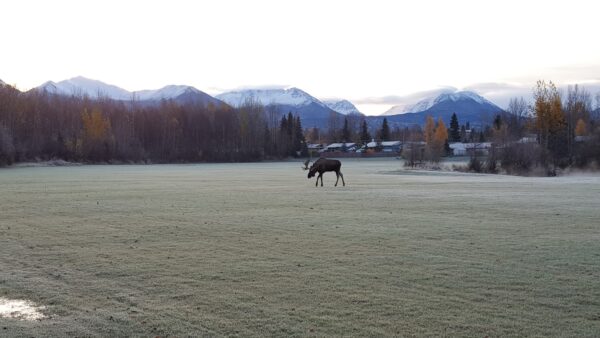
Anchorage residents gazing toward the nearby Chugach Mountains, as they are apt to do, may soon notice a sprinkling of snow at higher elevations.
But how do we know whether these first light snowfalls fit the definition of so-called “termination dust?” The answer is: We don’t.
National Weather Service climate researcher Brian Brettschneider — back for our Ask a Climatologist segment — wants to change that. Brettschneider says we need to agree on what counts as termination dust.
Listen here:
Brian Brettschneider: So what I came up with was that it needs to be clear. It needs to be obvious from town that, ‘Hey, there’s snow in the mountains.’ And it needs to be relatively widespread. And so I picked 4,000 feet as an elevation. So the highest peaks from Midtown Anchorage to South Anchorage go a little bit above 5,000 feet. And then I think it needs to persist for at least half a day, maybe even a little bit longer. So if you wake up and there’s some snow on those peaks in the morning, but then you step out for lunch and it’s not there anymore, it’s probably not significant enough to be called termination dust. Now, if it gets lower, if it gets to, say, down to Flattop Mountain elevation — which is 3,500 feet or lower — I think a lower amount of snow, we could probably say, ‘Yeah, that’s termination dust.’ And then the other thing is that it needs to be after the first of August. You know, in July, we haven’t even reached our warmest time of the year. So I think we need to be kind of on that downward trend of temperatures before we can say, ‘Yeah, this is under consideration for termination dust.’
Casey Grove: But Brian, I mean, who are you to decide this? I know you’re a big shot climatologist and all. But why are these the criteria? I mean, is it just that these are the things that seem to fit with the spirit of termination dust?
BB: That’s a good question. So I think in this warming world — and of course we are warming and there’s a lot of documentation to support that — when it comes to snowfall and the snow season, I’m very frequently asked, ‘What is our snow gonna be like? What’s our snow season going to be like in this warming world?’ And we have lots of ways to describe it in terms of: When’s the first snow? When’s the last snow? How much snow? How many days of snow on the ground? Is there snow on Halloween or Christmas?
And, when does the snow start to cover the mountains? Well that’s an important part of the whole climate picture as well. We don’t have a time series like we do for breakup, like we do now for green-up. And so what I’d like to do is build a time series, as a climate scientist, so that I can go and take this information — or someone a generation from now, hopefully — I can take this information and kind of extract some some useful meaning out of it. And so to that extent, someone’s got to take the first crack at it, coming up with these criteria. And I figured, well, I’ll just go ahead and do it myself.
[Sign up for Alaska Public Media’s daily newsletter to get our top stories delivered to your inbox.]
CG: And like all great climate-related data sets in Alaska, there has to be some betting behind this, right? Do you expect people we will be betting on termination dust in the future?
BB: Well, that’s why I’m doing it. Because I’ll place the biggest bet. And I’ll get to make the call. And then I’ll win, right? No (laughs), you know, of course, betting on breakup is a favorite pastime in Alaska. And, who knows, maybe that’s something people will do at some point in the future on when termination dust is. And, of course, if there’s money at stake, then there needs to be a very clear-cut criteria as to when that occurs.
CG: What’s actually going to happen here in the near future? Are we going to see termination dust anytime soon?
BB: Well, interestingly, the Anchorage National Weather Service forecast office, they put a note in there that said: There’s a chance — now this is not a forecast — but there’s a chance, and they actually use the word termination dust, could occur here in a couple of days, with a front and a shot of cold air. The timing all has to come together. It’s possible that the precipitation will end before the the cooler air moves in. So, keep your fingers crossed.
Brettschneider said he’s open to suggestions on termination dust, and you can post a comment on his blog: Brian B.’s Climate Blog.
Casey Grove is host of Alaska News Nightly, a general assignment reporter and an editor at Alaska Public Media. Reach him atcgrove@alaskapublic.org. Read more about Caseyhere.





